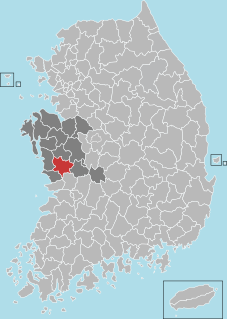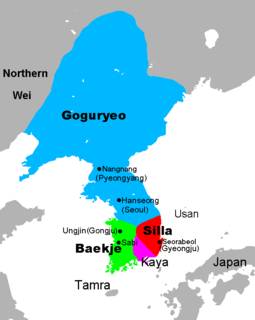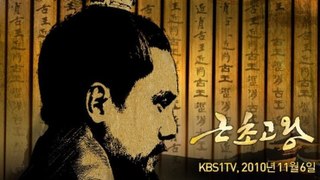
Baekje was a kingdom located in southwestern Korea. It was one of the Three Kingdoms of Korea, together with Goguryeo and Silla.
Sabi was the capital of the Korean kingdom of Baekje from 538 until Baekje's fall to Silla in 660. The site of Sabi is located in modern-day Buyeo County, South Chungcheong Province, in South Korea.

Buyeo County (Buyeo-gun) is a county in South Chungcheong Province, South Korea. Buyeo-eup, the county's capital, was the site of the capital of Baekje from 538-660 AD, during which it was called Sabi Fortress.

Buyeo, Fuyu or Puyŏ, was an ancient Korean kingdom centred around the middle of the Jilin province in Northeast China and existing as an independent polity from before the late 2nd century BC to the mid-4th century AD.
Uija of Baekje was the 31st and final ruler of Baekje, one of the Three Kingdoms of Korea. His reign ended when Baekje was conquered by an alliance of the rival Korean kingdom Silla and China's Tang dynasty.

Dongye, which means the Eastern Ye, was a Korean chiefdom which occupied portions of the northeastern Korean peninsula from roughly 3rd-century BC to around early 5th-century. It bordered Goguryeo and Okjeo to the north, Jinhan to the south, and China's Lelang Commandery to the west. Today, this territory consists of the provinces of South Hamgyŏng and Kangwon in North Korea, and Gangwon in South Korea.
Biryu of Baekje was the eleventh king of Baekje, one of the Three Kingdoms of Korea.
Samgeun of Baekje (465–479) was the 23rd king of Baekje, one of the Three Kingdoms of Korea. According to the Samguk Sagi, he was the eldest son of the 22nd king Munju.

Okjeo was a Korean tribal state which arose in the northern Korean peninsula from perhaps the 2nd century BCE to the 5th century CE.

Samhan, or Three Han, is the collective name of the Byeonhan, Jinhan, and Mahan confederacies that emerged in the first century BC during the Proto–Three Kingdoms of Korea, or Samhan, period. Located in the central and southern regions of the Korean Peninsula, the Samhan confederacies eventually merged and developed into the Baekje, Gaya, and Silla kingdoms. The name "Samhan" also refers to the Three Kingdoms of Korea.
Buyeo Yung (615–682) was the eldest son of King Uija, the last king of Baekje. He was appointed crown prince in 644, and would have been the kingdom's 32nd ruler. He is known as the progenitor of Buyeo Seo Clan where he changed his surname to Seo.

King Dongmyeong of Goguryeo or Dongmyeongseongwang, which literally means Holy King of the East, also known by his birth name Jumong, was the founding monarch of the kingdom of Goguryeo, the northernmost of the Three Kingdoms of Korea. In the Gwanggaeto Stele, he is called Chumo-wang . In the Samguk Sagi and the Samgungnyusa, he is recorded as Jumong with the surname Go. The Samguk Sagi states that he was also known as Chumo or Sanghae. The name is also transcribed in other records as Chumong, Jungmo, or Domo.

The language of the Buyeo kingdom is very sparsely attested; however, according to Chinese sources it was mutually intelligible with the Goguryeo language to its south. The few words which are known bear this out.
This is a partial list of Korea-related topics starting with B. For Korean words starting with ㅂ, see also under P.

Dongbuyeo was an ancient Korean kingdom that developed from Bukbuyeo, until it was conquered by early Goguryeo, which then grew into one of the Three Kingdoms of Korea. According to the Samguk Sagi, it was established when Buyeo's king Hae Buru moved the capital eastward by the sea.
Old Korean is the historical variety of the Korean language or Koreanic languages dating from the beginning of Three Kingdoms of Korea to the latter part of Later Silla, roughly from the fourth to tenth centuries CE.
Buyeo National Museum is a national museum located in Buyeo, Chungcheongnam-do, South Korea. Since Buyeo was once the capital of the Baekje kingdom during the Sabi period (538-660), the Museum is fully devoted to the Baekje culture.

The King of Legend is a 2010 South Korean historical drama based on King Geunchogo of Baekje. Besides historical information from Samguk Sagi and Samguk Yusa, it was also inspired by a novel written by Lee Munyeol, a renowned Korean writer. The drama aired on KBS1 in Korea, and internationally through KBS World.

Puyŏ, or Koguryoic, is a group of four languages of northern Korea and eastern Manchuria mentioned in ancient Chinese sources. The languages of Buyeo, Goguryeo, Dongye and Okjeo were said to be similar to one another but different from the language of the Yilou to the north and those of the Samhan to the south. Other sources suggest that the ruling class of Baekje may have spoken a Puyŏ language.

Ballad of Seodong is a South Korean television series starring Jo Hyun-jae, Lee Bo-young, and Ryu Jin. It aired on SBS from September 5, 2005 to March 21, 2006 on Mondays and Tuesdays at 21:55 for 55 episodes.










